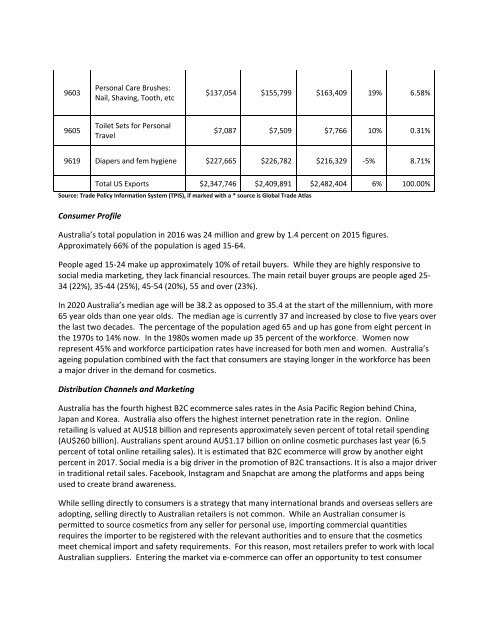Asia Personal Care & Cosmetics Market Guide 2016
AsiaCosmeticsMarketGuide
AsiaCosmeticsMarketGuide
You also want an ePaper? Increase the reach of your titles
YUMPU automatically turns print PDFs into web optimized ePapers that Google loves.
9603<br />
<strong>Personal</strong> <strong>Care</strong> Brushes:<br />
Nail, Shaving, Tooth, etc<br />
$137,054 $155,799 $163,409 19% 6.58%<br />
9605<br />
Toilet Sets for <strong>Personal</strong><br />
Travel<br />
$7,087 $7,509 $7,766 10% 0.31%<br />
9619 Diapers and fem hygiene $227,665 $226,782 $216,329 -5% 8.71%<br />
Total US Exports $2,347,746 $2,409,891 $2,482,404 6% 100.00%<br />
Source: Trade Policy Information System (TPIS), if marked with a * source is Global Trade Atlas<br />
Consumer Profile<br />
Australia’s total population in <strong>2016</strong> was 24 million and grew by 1.4 percent on 2015 figures.<br />
Approximately 66% of the population is aged 15-64.<br />
People aged 15-24 make up approximately 10% of retail buyers. While they are highly responsive to<br />
social media marketing, they lack financial resources. The main retail buyer groups are people aged 25-<br />
34 (22%), 35-44 (25%), 45-54 (20%), 55 and over (23%).<br />
In 2020 Australia’s median age will be 38.2 as opposed to 35.4 at the start of the millennium, with more<br />
65 year olds than one year olds. The median age is currently 37 and increased by close to five years over<br />
the last two decades. The percentage of the population aged 65 and up has gone from eight percent in<br />
the 1970s to 14% now. In the 1980s women made up 35 percent of the workforce. Women now<br />
represent 45% and workforce participation rates have increased for both men and women. Australia’s<br />
ageing population combined with the fact that consumers are staying longer in the workforce has been<br />
a major driver in the demand for cosmetics.<br />
Distribution Channels and <strong>Market</strong>ing<br />
Australia has the fourth highest B2C ecommerce sales rates in the <strong>Asia</strong> Pacific Region behind China,<br />
Japan and Korea. Australia also offers the highest internet penetration rate in the region. Online<br />
retailing is valued at AU$18 billion and represents approximately seven percent of total retail spending<br />
(AU$260 billion). Australians spent around AU$1.17 billion on online cosmetic purchases last year (6.5<br />
percent of total online retailing sales). It is estimated that B2C ecommerce will grow by another eight<br />
percent in 2017. Social media is a big driver in the promotion of B2C transactions. It is also a major driver<br />
in traditional retail sales. Facebook, Instagram and Snapchat are among the platforms and apps being<br />
used to create brand awareness.<br />
While selling directly to consumers is a strategy that many international brands and overseas sellers are<br />
adopting, selling directly to Australian retailers is not common. While an Australian consumer is<br />
permitted to source cosmetics from any seller for personal use, importing commercial quantities<br />
requires the importer to be registered with the relevant authorities and to ensure that the cosmetics<br />
meet chemical import and safety requirements. For this reason, most retailers prefer to work with local<br />
Australian suppliers. Entering the market via e-commerce can offer an opportunity to test consumer

















